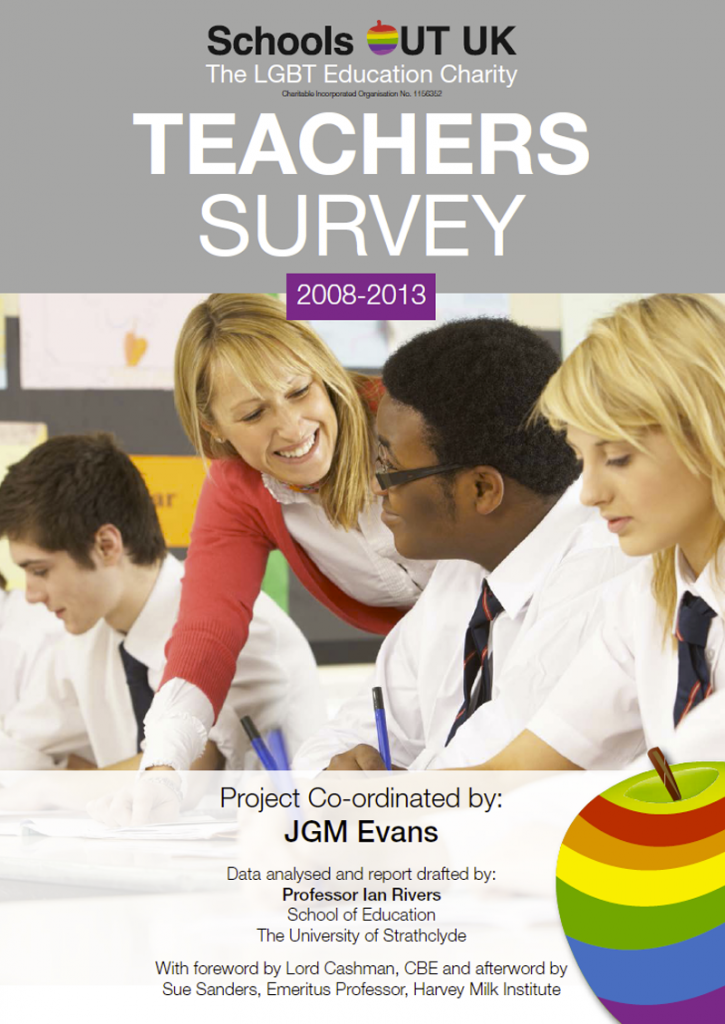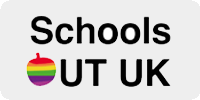More resources for Educators can be found at our sister sites below
LGBT History Month focuses on the celebration and recognition of LGBT people and culture; past and present to give educators scope to talk about the bigger picture of LGBT experience, in which LGBT people were the agents of change rather than just victims of prejudice. Most importantly for schools, resources have been created such as teaching packs and toolkits that cover lessons on sexual orientation and gender identity across the curriculum. This ensures that in every subject every teacher can make a positive difference. Homophobic/transphobic language and bullying, after all, could occur across the school, in any lesson. The phrase ‘whole school approach’ became crucial in school policies that now specifically mentioned sexual orientation.
Two specific types of teaching methods
Usualising
What does ‘Usualising’ mean?
You won’t find this verb in the dictionary. It means to make usual/everyday/ubiquitous. ‘Normalise’ is its closest synonym but normalise is problematic when describing humans as it assumes there is a ‘right’ way of being and is therefore a pejorative term to many who consider themselves outside the majority. It also has connotations of ‘trying to fit in’ rather than embracing diversity.
In what context is ‘usualise’ used?
When we usualise something, we acclimatise people to its presence, and take away the threat of difference which creates fear and discrimination. Usualising in schools has more to do with familiarizing learners with a subject’s everyday occurrence or existence rather than an in-depth understanding of the subject.
What does that look like when educating about LGBT?
Learners should consistently be made aware of the presence of LGBT people. LGBT people are integral to our learner’s lives. They exist in all times and all places. They exist in the here and now; essential to the UK society and culture. Schools rightly do not only use white, Christian references in their curriculum, but a range of resources/artefacts/case studies of people across race and religion. Teachers should try to use materials that span a diversity of sexual orientation. In the context of the Classroom ‘usualising’ occurs when a teacher references Lesbian, Gay or Bisexual sexual orientationwithout inviting further comment.
Example 1: A KS4 Geography lesson, looking at interesting facts of major world cities, cites San Francisco as having the largest percentage of same-sex households of any American city. The teacher does not invitediscussion of LGB lives because of this fact. It is simply 1 fact out of 20 facts that are given to describe SanFrancisco.
Example 2: A KS1/2 SEN lesson on appropriate touch, shows pictures of different types of people in different forms of physicalcontact. There is a picture of a gaycouple holding hands, and a picture of a lesbian couple kissing. These images are presented simply as fact and are included amongst images of opposite sex physical contact.
Usualising is done indirectly. Usualising is not an instructional method, rather it is referential. It is best used in subjects with programmes of study that do not relate to knowledge of identity, or discrimination e.g. Maths, D&T, PE, ICT, MFL etc. and where the objective is to learn subject specific key skills. To the teacher who commits to the process, it is a method of teaching that does not require in-depth knowledge of the subject. Diverse sexual orientations are not open for analysis; the teacher simply has to refer to their existence.
So how does that help challenge homophobia/transphobia?
Consider: When an infant sees a spider for the first time, is it afraid? When the infant sees the parent scream and shout every time a spider appears, does not the infant then learn it should be afraid?
Usualising therefore is the non-comment, the non-judgement, the non-reaction. It is the inclusion through reference, not instruction. It is the tacit approval of acceptability, and it must be used frequently for that acceptance to be embedded in the learner.
Usualising LGBT lives means that learners are made aware of the diversity of LGBT people, that they are found in every culture, near and far, and that they share many characteristics with people who are heterosexual. It is also about acknowledging the differences between LGBT individuals themselves, that they do not all conform to the same behaviours/appearance.
In this way usualising tackles prejudice. Usualising can be used to make visible any minority group.
Actualising
Previously we learned about usualising and how it acclimatises children to the existence of something (e.g. LGBT people). This prepares children to be taught in more detail about those lives later on. This more in-depth teaching is the second teaching method we employ. It is called ‘actualising’ and involves lessons with specific objectives that include a greater understanding of LGBT identities, and their impact on people and culture.
Don’t you mean ‘actuating’ or ‘actuate’?
These words are similar in meaning but actuating describes putting something in motion and connotes real movement. This could be true if you likened it to putting thoughts in motion, but ‘actualising’ also involves a language of description and analysis that doesn’t necessarily require the learner to have to engage i.e. they can still be passive learners. Actualise merely describes the fact that they are aware that they are learning about LGBT lives. In ‘usualising’ this is not always the case.
Okay, so what does it mean?
To make real in the minds of a learner. To explain; to examine and make concrete a subject so that the learner can put it in a real life context. Once pupils are habituated to something (LGBT life) they can then study it without distraction. Actualisingdescribes and disseminates subjects that usualising has made an acceptable part of reality.
Example 1: A KS2 PSHE lesson covering different types of relationships, including those within families and between older and young people, boys and girls, and people of the same sex, including civil partnerships. The inclusion of LGBT people is not simply referential because the teacher wants the class to consider the validity of civil partnerships in comparison to marriage. The objective (for pupils to explain why it is sometimes harder for LGBT people to be open about their relationship) requires discussion and examination of LGBT relationships. In doing so, LGBT lives are made concrete.
Actualising means presenting the subject in some fuller aspect. It should include the positives and negatives as well. We are not making value judgements, nor are we encouraging bias in favour of LGBT life by ONLY representing positive images of LGBT people.
Example 2: A KS5 Citizenship lesson entitled ‘Perspective on LGB Rights’ asks learners to discuss a range of opinions in relation to homosexuality and the rights of Lesbian, Gay and Bisexual (LGB) people; in particular they are asked to think about homophobic bullying in schools and about ongoing debates concerning same-sex parenting and adoption. Here we go into some detail with learners about LGB life and learners are exposed to current controversial debates. In doing so, the teacher is not asking the children to make value judgements over LGB people’s suitability as parents (that is not up for debate) but in highlighting the controversy learners begin to understand how prejudice and discrimination can impact upon a particular group.
Section 28 Resources
2013 was the 25th anniversary of the arrival of the local government censorship law Section 28, and the 10th anniversary of its repeal.
As part of our commemorations we have created a bank of resources covering the 15 year period that Section 28 was in place, charting the opposition to its creation by Margaret Thatcher’s administration, which led to the setting up of Stonewall, the opposition during its lifetime which led to some of the biggest street demonstrations ever witnessed on the streets of London and Manchester, and its protracted demise, which strangely took until the second term of Tony Blair’s government to achieve.
This material is only a small part of papers relating to Section 28 in the archives of the London School of Economics. The material is available to the public by appointment.
We would like to add to our own archive, and would particularly like to include photographic evidence of that inspirational opposition. Please send us anything relevent that should be seen – either by the current generation of LGBT teachers, academics and activists who were too young to have experienced it, or by those upcoming LGBT people who will otherwise not know it even existed. Please email us on chairs@schools-out.org.uk
This Prevalence of Homophobia survey was born out of the experiences of one secondary classroom teacher who was the subject of repeated physical and verbal abuse over a number of years. The abuse, as if often the case came mainly from a the small group of young lads whose grasp on their ‘masculine’ stereotype of fragile but was ameliorated in part by the common-sense acceptance of the diversity exhibited by the majority of students and staff. The real problem was the point-blank refusal of the school management to challenge such ignorance and thereby endorse the acceptance of diversity shown by the majority of the school.

NUT Prevalence of Homophobia Survey
Teachers want to be trained in how to deal with homophobia in our schools and we have the evidence.
Homophobia in our schools has been described as ‘epidemic’, the ‘last bastion of the bully’ and ‘the elephant in the room’. Following the Teacher Support Network/Times Education Supplement survey of teachers in 2006 and the Stonewall School report on 2007, the NUT Prevalence of Homophobia Survey began in 2008 in Oldham and further surveys have since rolled out across the North of England. Surveys have been carried out in Oldham (2), Salford, Trafford, Lancashire, Blackpool, Liverpool, Blackburn and Darwen. They are being organised in Nottingham, Brighton and Wakefield and can be found on the Schools OUT website www.schools-out.org.uk. They have all shown that:
- Homophobic behaviour is commonplace
- Teachers can be targets as well as students
- There is a significant demand for whole school training to deal with it.
Following the findings of these surveys, the NUT Luton Division was the first to carry out the survey outside the North and the East Midlands. We hope it will be the first of many.
These surveys are live and ongoing.
All the surveys and their findings are published below. These collected findings are exclusive to Schools OUT
(please note the Birmingham Students’ Survey is also available as an attachment)
Anecdotes such as this are sadly not uncommon, the goal of this survey was to provide a quantitative and qualitative voice to the thousands of the extra-ordinary teachers who everyday not only educate but provide for so many children the first line of child protection from bullying and other abuse. They are in an ideal position to advise of the extent of homophobia and what they need to better protect the children in their charge and thereby better challenge the ignorance that perpetuates such abuse.
Perhaps is it a measure of the distance between claims about priority of child protection in our society that this survey enjoyed no funding stream to finance relying completely on the voluntary endeavours of thousands of teachers, their unions and in three most welcome cases the local education authority. A number of obstacles were placed in our way seeking to either stop or bury this project over the last five years! Indeed, the only way this report has seen the light of day is through the good auspices of educational charity Schools OUT UK to whom we are most grateful
What has emerged with the kind assistance Prof Ian Rivers is the largest survey of classroom teacher’s measure of the extent of homophobia our children have to face on a daily basis in their schools tougher a professional reading of what classroom teachers required to affectively challenge such ignorance. How children are treated is a measure of the civility of a society – the hope is that this survey will help provoke action to make our schools safer, happier and more inclusive places to learn about our world and not least the of the wondrous joy of human diversity.
This survey is then the product of a lot of hard work by a large number of people over a number of years together the thousands of classroom teachers who took time from their impossible workloads to complete the questionnaire all of whom I congratulate and offer my sincere thanks.
Jeff Evans
Project Coordinator 2008-2013
NUT Prevalence of Homophobia survey results:
- Birmingham 2013 (New)
- Blackburn-with-Darwen 2010 (primary)
- Blackpool 2010 (secondary)
- Bury NUT 2009
- Doncaster 2013
- Greater Manchester 2012
- Kirklees 2012
- Lancashire 2012
- Lancashire 2009 (secondary)
- Liverpool 2010 (secondary)
- Luton 2011 (secondary)
- Oldham 2008 (secondary)
- Oldham 2010 (secondary)
- Salford 2010 (primary & secondary)
- Tameside NUT 2012
- Trafford NUT 2009
- Warrington NUT 2010
- Wirral NUT 2010


